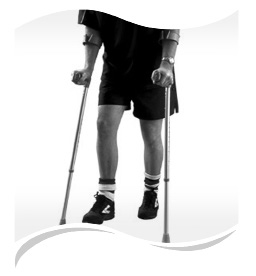Walking Aids – Elbow Crutches
How to use your Elbow Crutches
How to use your Elbow Crutches or two walking sticks
Elbow crutches and two walking sticks are used by a variety of people for different reasons such as:
- If you are recovering from injuries requiring partial weight-bearing through the injured limb.
- If you have reduced balance, strength or endurance when walking.
- If you have pain, weakness or instability in any part of your leg, for example; hip, knee or ankle.

How to use
- Ensure your arms are secured in the cuff if using crutches.
- Place both crutches/walking sticks one step in front of you.
- Move your affected leg forward level with the crutches/walking sticks.
- Step to or through with the other leg.
- Do not place your crutches/walking sticks too far in front of you, or too far out to the side.
CHAIRS
Getting Up
- The crutches/walking sticks should be near the arms of the chair.
- Put your hands on the arms of the chair, lean forwards and push yourself up to stand.
- Ensure your arms are secured in the cuff if using elbow crutches before holding the handles.
- Always pause for a few seconds before walking off.
Sitting down
- Turn until you feel the chair against the back of both legs.
- Release your arms from the cuff if using crutches.
- Put the crutches/walking sticks down close to you.
- Place your hands on the arms of the chair, bend forward and slowly lower yourself into the chair.
A useful video can be found here on how sit to stand and walk with crutches when partially weight bearing: https://www.youtube.com/watch?v=j2nDUbSGmyc
A useful video can be found here on how to use elbow crutches when Partial Weight bearing: https://www.youtube.com/watch?v=E2TLpIX52q4
A useful video can be found here on how to use elbow crutches when Non Weight bearing:
STAIRS
- Only attempt the stairs yourself if you feel safe, otherwise ask someone to help you.
- Place one hand on the handrail and the crutches/walking sticks in the other hand.
- You may wish to use the “T” hold. This will have been demonstrated to you by your physiotherapist if appropriate.
Upstairs
- Step up with your good leg, followed by your affected leg onto the same step.
- The crutches/sticks are the last to move up level with your feet.
Downstairs
- Place your crutches or walking sticks safely on the lower step keeping them away from the edge.
- Step down with the affected leg.
- Follow with the good leg onto the same step.
- Make sure you place the whole foot onto the step.
- Always take your time.
A useful video on how to use elbow crutches when climbing stairs with no bannister
https://www.youtube.com/watch?v=SzGyTd7vQYE
A useful video on how to use elbow crutches when climbing stairs with one bannister
GENERAL SAFETY
- Regularly check your elbow crutches for bends, or loose handles.
- Check the rubber (ferrule) on the bottom of the crutches has not worn smooth or split. These can be replaced at your local physiotherapy department.
- Remove any loose mats and rugs to prevent tripping,
- Make sure lighting is adequate around the house.
- Wear flat supportive shoes that fit well.
- Have your eyesight checked regularly (if over 65, annual check ups are advised)
- Be aware of hazards including wet floors, uneven surfaces, wet leaves, ice.
- Do not carry too many bags.
Your Feedback – comments, concerns and complaints
NHS Lanarkshire is committed to improving the service it provides to patients and their families. We therefore want to hear from you about your experience. If you would like to tell us about this please visit our feedback page.


